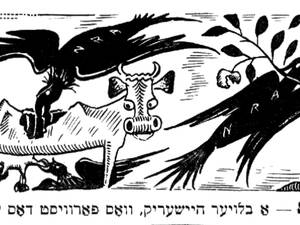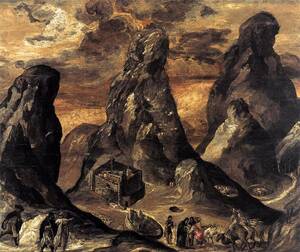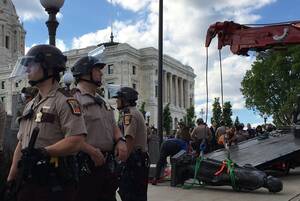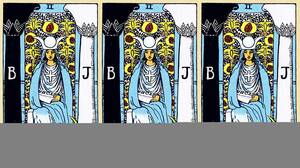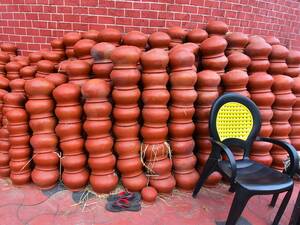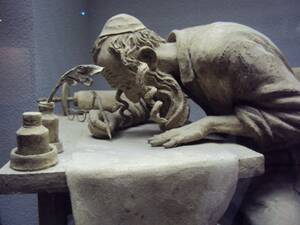Exodus: Vayakhel
After a political rupture, rituals of repetition can attempt to restore normalcy—or throw it into question.
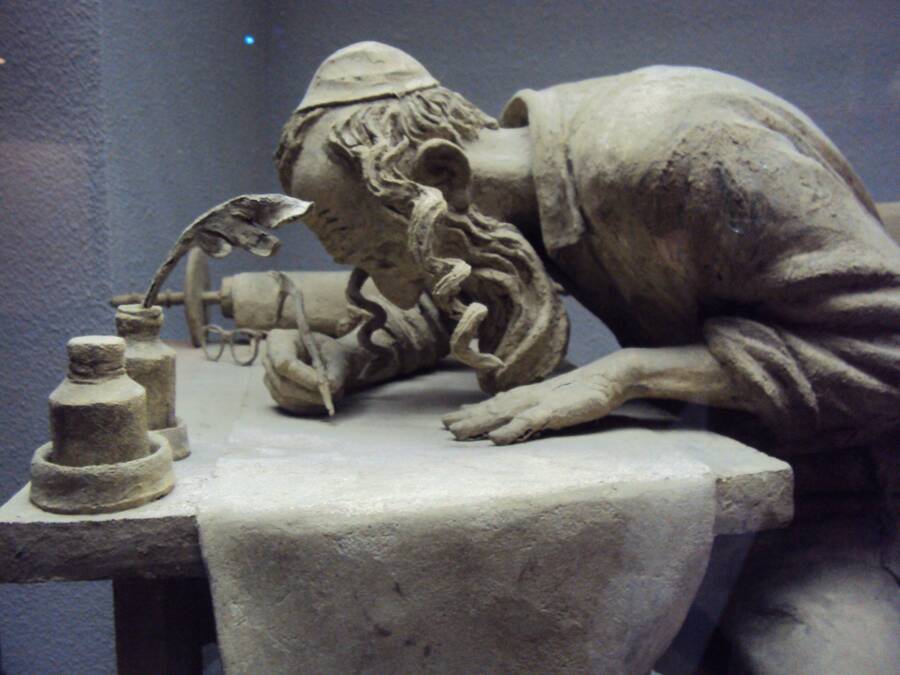
Read previous entries of Slow Burn: Quarantine Edition here.
Vayakhel
Exodus 35:1 – 38:20
Oakland, CA
Dear Rereaders,
All readings are rereadings, Vladimir Nabokov thought. Maybe so—but some more than others. Jews, of course, cycle through a Torah scroll each year, then rewind and repeat. Readers of Vayakhel, the tenth parsha of Exodus, may feel especially strongly that they are watching a rerun, because this parsha duplicates material nearly verbatim from Terumah, four parshas earlier, about the construction of the Tabernacle. Carina’s description of that material as the stuff of “an upscale IKEA pamphlet” applies to Vayakhel as neatly as a peg from one Malm bed fits another. Things have developed, to be sure, in the interim: Where Terumah introduces God’s minute instructions for building the traveling sanctuary, Vayakhel narrates the actual process of construction: the people’s contribution of raw materials, the designation of chief artisans. But the later parsha continually rehashes the details of the Tabernacle’s blueprint in describing its realization: The length of each curtain, the copper clasps to fasten the Tent together, the silver sockets, posts of acacia wood, the lampstand of pure gold are all described exactly as they were the first time. Even when chapters in Vayakhel stray slightly from their originals in Terumah—“You shall make fifty loops in the one curtain” becomes “He made fifty loops in the one curtain”—the divergence only intensifies the sense of repetition by underscoring the perfect fulfillment of God’s command.
Why this repetition? Some commentators explain that it was simply a fashionable style thousands of years ago—a technique “dearly beloved of the writers of the ancient East,” as the Italian scholar Umberto Cassuto wrote in his 1951 Commentary on the Book of Exodus. Cassuto’s glib historicist answer isn’t wrong, even if his insistence that repetition is alien to “modern concepts” is belied by the fact that he offers his explanation at least four times in 20 pages. But his argument illuminates nothing about this repetition in particular.
I found a more specific explanation in a reading by the contemporary scholar Amy Cooper Robertson: The recycling of the Tabernacle texts indicates that they are not practical directions or architectural description, but rather a ritual litany. As Robertson notes, the twin parshas bracket the central trauma of the second half of Exodus, in which the people forge a Golden Calf and throw a rave while awaiting Moses’s return from the top of Mount Sinai, eliciting a divine plague and Levitical police crackdown. Much as Isaac, in his letter, reads the Calf incident as precipitating “the fundamental struggle to live with the weight of our actions,” Robertson thinks that after this rupture, the “developing relationship between God and Israel will feel terribly precarious once again.” In her view, then, the textual repetitions of Vayakhel are intended to soothe us like a chant, “recreating [a] sense of eternity and granting a familiar foothold.” Logically, Robertson’s argument persuades me; emotionally, I am unsatisfied. To me, this theory leaves God looking desperate and pushy, like John Cusack in the Say Anything... boombox scene, serenading Ione Skye with the tune that was playing when he first, in the biblical sense, knew her. So perhaps my question is not, “Why is this repetition necessary?” but “Why is the answer to the Calf a repetition that feels so inadequate?”
I began writing this letter not long after another inadequate performance of repetition designed to contain a traumatic eruption of violence: the inauguration of Joe Biden. Of course, inaugurations, as rituals of continuity, are inherently repetitious. But Biden’s pageantry seemed unusually derivative in its frequent allusions to Obama’s inauguration and presidency. The core message of Biden’s speech—“This is our historic moment of crisis and challenge, and unity is the path forward”—was cribbed from Obama’s first inaugural; the National Youth Poet Laureate Amanda Gorman repeatedly cited court playwright Lin-Manuel Miranda’s Hamilton, which reimagined the founding father in Obama’s image. Even in celebrating the unprecedented, Biden drew on Obama’s precedent, extolling the election of a Black woman vice president with a phrase that harkened back to the sunny hopefulness of Obama’s first presidential run: “Don’t tell me things can’t change.” In these triumphant echoes, you were supposed to hear a comforting progressive message: The more America changes, the more she becomes herself.
If the aestheticized repetition in Exodus was meant to suture the wound of the Golden Calf riot, the recent inauguration aimed to heal the country after the disruptive presidency of Donald Trump, of whom conservatives have now crafted a literal golden idol; this rupture culminated in its own spectacular riot on January 6th. Even as Biden’s repetitious inauguration was a séance to summon Obama’s spirit, it was also an exorcism of Trump’s. But in contemporary America as in Exodus, even as repetition aims to smooth over a disturbing interruption, the interruption also transforms how you hear the repetition: The echoes of a glorious past sound newly hollow and tinny. In 2009, I could believe that morning had come to America. I felt like an Israelite being shown a vision of a splendid new sanctuary: fine twisted linen of blue, purple, and crimson yarns; gold, silver, and acacia; and in the center, an Ark containing a copy of Dreams of My Father. But the shoddy construction of this sanctuary soon became evident. The Democrats passed a healthcare plan designed by the Heritage Foundation, Obama redeployed troops to Iraq, and Tim Geithner sold off foreclosed homes to venture capital. Who, after living through the last decade, could possibly believe Biden’s promise that the “dream of justice for all will be deferred no longer”? Obama’s inaugural spectacle was supposed to signify the promise of the future. Biden’s show points instead to Obama’s show—to the promise of the past.
The Tabernacle too might be a nostalgic spectacle, whose showy physicality accommodates Israelite backwardness. In an influential line of rabbinic commentary, God commands the construction of the sanctuary only after the creation of the Calf, when, as Abraham Joshua Heschel writes, “the people had succumbed to the temptation of worshipping a thing.” The Israelites remain addicted to the idolatry they learned in Egypt, so they are offered a transitional object, a weaker and less dangerous illusion. (To explain why, on this theory, the instructions first appear before the making of the Calf, the great medieval exegete Rashi shrugs and says, “there is no earlier and later in the Torah.”) Wherever it appears, this liberal reformism tries to wean the people off their idols with a kinder, gentler nostalgia: Make America normal again.
REPETITION CAN SOOTHE AND REASSURE, but it can also defamiliarize and estrange. In his 1935 essay “The Work of Art in the Age of Mechanical Reproduction,” Walter Benjamin argues that the advent of techniques of industrial manufacture and replication attenuated premodern artworks’ “cult value,” a numinous “aura” derived from their unique materiality and specific location. In essence, Benjamin contended, older artworks were idols that modernity had disenchanted. The modern artwork is not used in a ritual but rather exhibited as spectacle, and the temple is replaced by the museum. Art moves out of the inner sanctum, becoming available to the masses—and thus for public, political debate.
Reflecting on the repetitions in Vayakhel made me think about Benjamin’s formulation, in which replication serves to demystify the sacred. But the stark dichotomy he draws between the premodern and the modern overlooks the way this tendency in fact long predates the modern world, and indeed appears even in the kind of ancient religious writings from which he drew the idea of the cult object. Writing itself, after all, is mechanical reproduction avant la lettre. Centuries before the invention of the printing press, Jewish scribes were trained not to acquire but to suppress an individual style, the goal being not calligraphic distinctiveness but uniformity. One aleph is, or is supposed to be, the same as another. Text has no locale, is not bounded or unique: You copy it freely, you recite it over and over. Perhaps when you do so, you disenchant the sanctuary.
Contra Robertson, then, the repetition in Exodus might function not as a balm but as a disenchantment. For the Israelites, those fifty loops have each to be sown laboriously by hand, but a writer can reproduce them as easily as they please: fifty loops, fifty loops, fifty loops. Look, the repetition tells us, this is not the awe-inspiring candelabrum, the eternal golden burning bush flickering with the presence of the deity; it is just a piece of text. Read this way, Vayakhel does not want us to replace the Golden Calf with a harmonious, eternal sanctuary; rather, it invites us to recognize that the latter can become an idol as easily as the former—and that both need to be critiqued, even disenchanted.
What would Vayakhel feel like, how would it land emotionally, if it was a critique and not a mollification? It’s useful, perhaps, to flip back to the mystifying ritual of inauguration, which was briefly demystified through a kind of mass-produced repetitive artwork: the widely circulated image of an old man, crotchety, cross-legged, functionally dressed in a puffy coat and oversized mittens. The meme first gave solace to leftists who identified with the elder statesman’s barely-repressed agitation, was soon appropriated by liberals who delighted in the image of a curmudgeonly Bernie defanged, and finally mutated under the ceaseless, polymorphic pressure of digital file editing into an excuse simply to photoshop Bernie into any context, to make him a Desi or a Hasid or whatever you liked. But paradoxically, the empty formalism of the exercise only sharpened the image’s parodic function. As the edifice of the American state, with enthusiastic media cooperation, insisted that the proper series of deictics—this president-elect repeating the words of this oath on this family Bible on this day of January 20, 2021—would felicitously transfer power and complete the rite, the image of Bernie emphasized the opposite: not the official story but an unexpected punctum; not a tightly choreographed show but a deluge of content; not him, us.
The genius of the Bernie memes is that they are funny, and so suggest that debunking can be play, that it can be fun. Like Charlie Chaplin’s body contorting robotically on the factory line in Modern Times, they offered us a disenchanted, mechanical world not through a didactic sermon but as a joke. It might seem counterintuitive to suggest that Vayakhel works similarly; the parsha, after all, is a largely humorless affair devoted to the enacting of the Law. But there is one moment in which its repetitiveness seems to me deliberately comic, a joke made at the expense of its own longwindedness. The parsha tells us that the people generously bring wool, linen, gold and silver, all the requisite materials for the Tabernacle’s construction—but then they overdo it, stressing out the craftsmen tasked with turning these materials into curtains, cherubim, and other finished products. Finally, these artisans complain to Moses, “The people are bringing more than is needed for the tasks entailed in the work that God has commanded to be done.” Moses declares in response, “Let no man or woman make further effort toward gifts for the sanctuary!” The text goes on—what follows is my translation—“So the people were restrained from bringing: for the work was enough for all the work to be done and too much.”
Commentators and translators have tried their best to iron out the last line’s unreadable tautology: The Israelites’ past efforts are enough for the future work, or their stuff is adequate to the task. In the most recent translation of the Hebrew Bible released by the Jewish Publication Society, for instance, the text is silently emended so that the people stop themselves, eliminating the undignified insinuation that, like the water-carrying broom in The Sorcerer’s Apprentice, they must be physically blocked from contributing. But these alterations exclude the possibility that the verbal duplication is a wry, self-aware comment on the repetitiveness of the parsha as a whole: “Yes,” I think, encountering this litany of interior decoration for the second time, “the work is enough for the work—and too much.” The translations manufacture an orderly text and an equally disciplined community, but the original Hebrew suggests instead ridiculous, ungapatchka excess: supply outstripping demand, freewill offerings piling up uselessly, the warehouse so overstuffed it resembles a junkyard. (I am reminded of Pratima’s description, in her letter on Tetzaveh, of temples in Kerala, India, with their “overflowing storage rooms full of utensils in disuse.”) Lurking in this image, perhaps, is the intrinsic absurdity of amassing wealth to please the Infinite, the sense in which the Sanctuary was always already a redundant repetition: “The heaven is My throne, the earth My footstool, and you are taking measurements for curtains?”
This self-reflexive reading inevitably invites another one: that the traveling sanctuary itself is built on a shaky foundation; it is constructed only to be deconstructed, its repeated relocation a cycle of sanctifying and secularizing space, bewitching and disenchanting. Here we have to forsake Benjamin’s dichotomy altogether: It is not the text that critiques the Tabernacle, but the Tabernacle that critiques itself. In this vein, the Ishbitzer Rebbe, Mordechai Yosef Leiner, notes that when God commands Moses to “carve” a second set of tablets (after he shattered the first set at the sight of the Calf), God uses the same word with which the Ten Commandments outlawed any “carved image”—suggesting to the Ishbitzer the danger of the tablets producing an overly fixed or rigid ideology, the threat of bibliolatry. In this account, we might say, Moses encounters the Calf only to realize he is already carrying it in his arms. By courting paradox in a similar way, perhaps the sanctuary serves not to pacify the people in the wake of destruction, but rather to goad us to imitate Moses’s breaking of the tablets, the smashing of the image of the Law in order to protect it. The structure cries out, “Take me to pieces.” Yet this incitement is only one of its enticements—alongside the renunciation of idols, there is the smell of incense and roast meat, the light shimmering on the rippling tapestries. Wandering in the wilderness, and offered only the austere ineffable Law of a God they cannot see, the Israelites might easily despair. The sanctuary affords them nurturing illusions consistent with a rigorous iconoclasm.
In our own time and place, as the snow melts and vaccines are distributed, the usual parties are celebrating the end of the winter of our discontent and a “return to normalcy.” The obvious danger of such rites of spring is that you might believe in them; the subtler danger is you might learn not to believe in anything at all. The Tabernacle, as it is assembled and disassembled, solicits your wonder and chastises it, demanding a reading that is alternately cynical and deluded, always revising itself, always aware of the absent absolute to which it gestures and which it obscures.
Yours in solidarity and illusion,
Raffi
Raphael Magarik is an assistant professor of English at the University of Illinois at Chicago.



